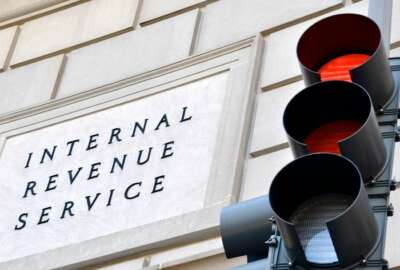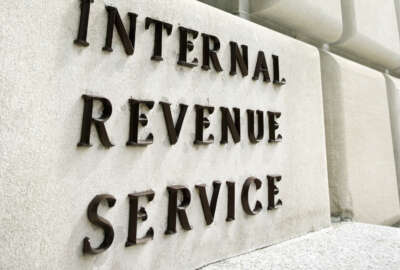

If you're posting on Facebook or Twitter about the IRS taking too long to send your federal tax refund check, or grumbling about long wait times on tax help...
Best listening experience is on Chrome, Firefox or Safari. Subscribe to Federal Drive’s daily audio interviews on Apple Podcasts or PodcastOne.
To those posting on Facebook or Twitter about the IRS taking too long to send your federal tax refund check, or grumbling online about long wait times experienced on tax-help hotlines, there’s a good chance the agency is listening.
More than that, the IRS uses social media posts to determine if there’s a larger problem that exists in their systems.
“During filing season, what are people saying about the filing process, about the timeliness of their refunds, about hold times? Because that can give us a really quick insight into areas where there might be a problem occurring,” IRS Chief Risk Officer Tom Brandt said Tuesday at REI Systems’ Government Analytics Breakfast in Washington, D.C. “Today, the minute they’re dissatisfied with something, they’re tweeting. If you’re paying attention to that, that can give you an insight to where there might be a problem.”
Tracking social media feedback is just one piece of the IRS’ larger Enterprise Risk Management (ERM) program. Since 2014, ERM has helped the agency carry out its mission while ensuring security.
The program consists of the IRS commissioner, the executive risk committee chaired by Brandt, two deputy commissioners, a rotating set of other executives and a risk working group made up of senior-level staff from all agency units.
And in an era of diminished agency resources, the ERM program has to rely on tools to make its current workforce as efficient as possible.
“As we’ve dealt with a reduction in staff and a reduction in resources, it really is essential for us to look at improving the way in which we identify the most critical and most important work for the IRS,” Brandt said. “I think what this demonstrates is a recognition of how key data analytics is to the IRS’ future.”
Since 2010, Congress has cut the IRS budget by nearly $1 billion, and by more than 17,000 employees. But as the IRS implements its new long-term strategy, the agency may also soon see a spending boost on from Congress.
In May, the House Appropriations Committee released a spending bill that would fund the IRS by more than $186 million above current levels.
Of those funds, $77 million would go toward implementing the new tax reform law. The bill would also give the IRS’ Taxpayer Services division an additional $31 million above current levels to improve its rate of answering calls on its tax-help hotline, prevent fraud and shore up its cyber defenses.
More recently, the IRS recently launched its five-year strategic plan, a six-point roadmap to modernizing the agency.
Of the six points outlined in the strategic plan, Brandt said the goal of advancing data access, usability and analytics to inform decision-making holds particular relevance for the ERM program.
“Across government, we are challenged with aging technology infrastructure,” Brandt said. “Certainly cyber and data security is a key risk throughout. I think all of us have been dealing with challenges around staffing. A real critical area of focus for us is to be able to provide secure access to the services that we’re trying to make available to taxpayers.”
The IRS is especially attuned to mitigating risk around implementing the new tax reform law President Donald Trump signed late last year, protecting taxpayer rights and safeguarding taxpayer data.
“A critical point here is that this doesn’t work unless every employee in the organization supports risk management, so we do want to emphasize that every employee does have a role in helping to support the identification and management of risk,” Brandt said.
Since the IRS convened its first security summit in 2015, the agency reports that taxpayer-reported cases of identity theft have decreased by 64 percent. Still, Brandt said it remains an ongoing challenge to stay one step ahead of fraudsters.
“Refund fraud is a significant challenge for the IRS, partly because there’s so much information out there on all of us that it is, I think, a continuing challenge to authenticate that we are dealing with a legitimate taxpayer and not a criminal who has enough information to authenticate as you, the taxpayer,” he said.
In order to fight fraud, the five-year strategic plan calls for improved partnerships between the IRS, state tax agencies and private-sector companies through the agency’s annual security summits.
“I think one of our areas of concern is making sure that we are securing all of the information that we compile to operate the tax system in the United States,” Brandt said.
In order to meet these and other goals under the five-year strategy, Brandt said the IRS has considered adopting emerging technologies such as blockchain. He said it was an area identified as an emerging opportunity.
“It is something that the organization is looking at from the operational standpoint, in terms of, might that affect the tax system and the way in which the IRS administers tax, but also what are some of the opportunities of how IRS could leverage blockchain in trying to reduce some of the risks in these areas,” he said. “But I would say we’re in the early stages of that.”
Copyright © 2025 Federal News Network. All rights reserved. This website is not intended for users located within the European Economic Area.
Jory Heckman is a reporter at Federal News Network covering U.S. Postal Service, IRS, big data and technology issues.
Follow @jheckmanWFED



